inflation pressure PEUGEOT 4008 2014.5 Owners Manual
[x] Cancel search | Manufacturer: PEUGEOT, Model Year: 2014.5, Model line: 4008, Model: PEUGEOT 4008 2014.5Pages: 389, PDF Size: 15.75 MB
Page 6 of 389
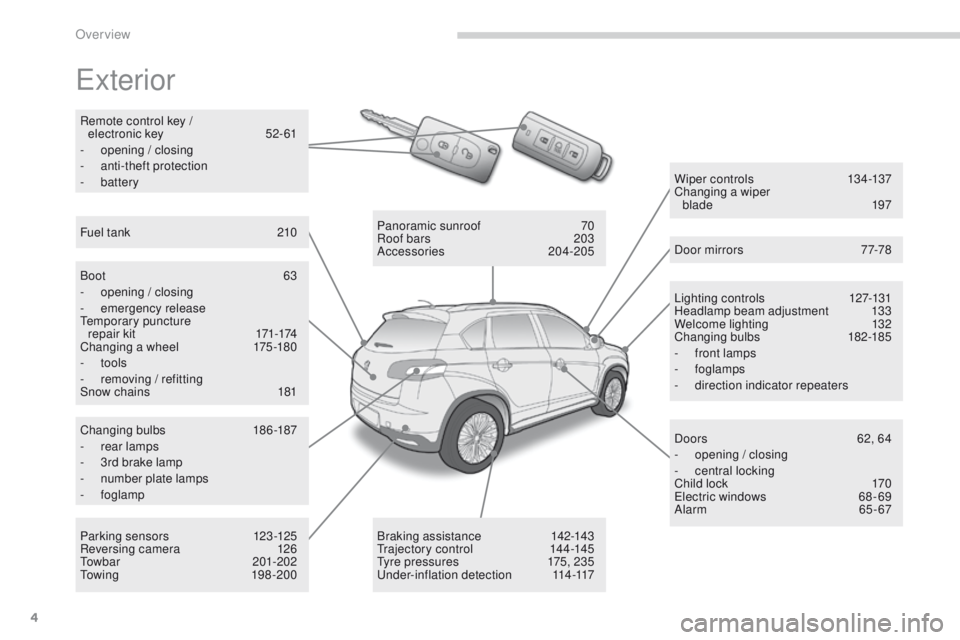
4
exterior
Lighting controls 127-131
Headlamp beam adjustment 1 33
Welcome lighting
1
32
Changing bulbs
1
82-185
-
f
ront lamps
-
foglamps
-
d
irection indicator repeaters
W iper c ontrols
13
4 -137
Changing a wiper blade
197
Door mirrors
7
7-78
Doors
6
2, 64
-
ope
ning / closing
-
c
entral locking
Child lock
1
70
el
ectric windows
6
8 - 69
Alarm
65-67
Panoramic sunroof
7
0
Roof bars
2
03
Accessories
20
4-205
Braking assistance
1
42-143
tra
jectory control
1
44-145
ty
re pressures
1
75, 235
un
der-inflation detection
1
14-117
Boot
63
- ope
ning / closing
- em
ergency release
te
mporary puncture
repair kit
1
71-174
Changing a wheel
1
75-180
-
tools
-
r
emoving / refitting
Snow chains
1
81
Changing bulbs
1
86-187
-
r
ear lamps
-
3
rd brake lamp
-
n
umber plate lamps
-
foglamp
Parking sensors
1
23-125
Reversing camera
1
26
to
wbar
20
1-202
to
w i n g
19 8 - 2 0 0
Fuel tank
2
10
Remote control key /
electronic key
5
2-61
-
ope
ning / closing
-
a
nti-theft protection
-
battery
Over view
Page 17 of 389
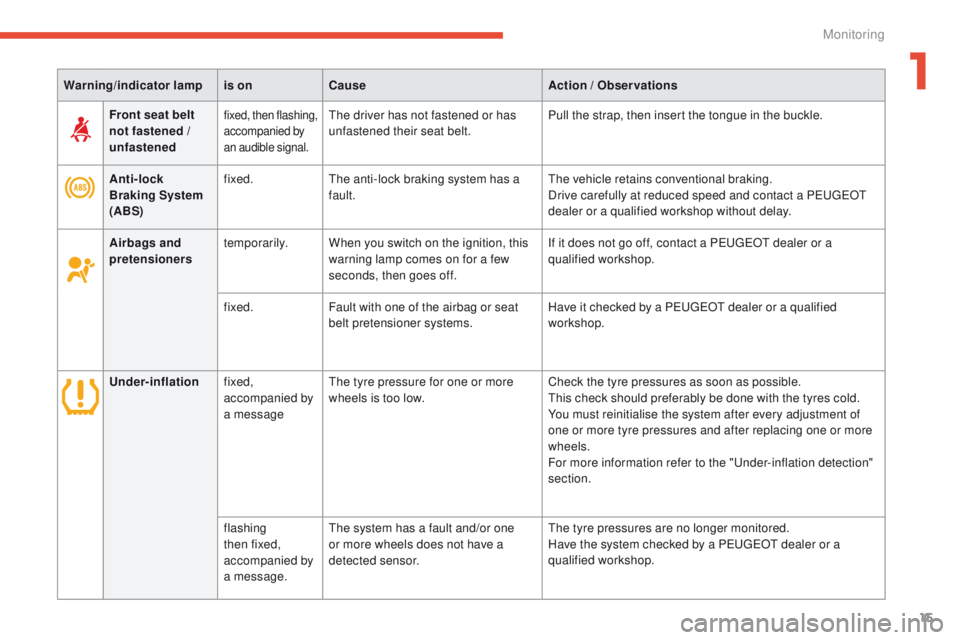
15
Warning/indicator lampis on Cause Action / Observations
Anti-lock
Braking System
(ABS) fixed.
th
e anti-lock braking system has a
fault.
th
e vehicle retains conventional braking.
Drive carefully at reduced speed and contact a P
e
uge
Ot
dealer or a qualified workshop without delay.
Front seat belt
not fastened /
unfastened
fixed, then flashing,
accompanied by
an audible signal.the driver has not fastened or has
unfastened their seat belt.
Pull the strap, then insert the tongue in the buckle.
Airbags and
pretensioners temporarily.
When you switch on the ignition, this
warning lamp comes on for a few
seconds, then goes off. If it does not go off, contact a P
e
uge
Ot
dealer or a
qualified workshop.
fixed. Fault with one of the airbag or seat
belt pretensioner systems. Have it checked by a P
e
uge
Ot
dealer or a qualified
workshop.
Under-inflation fixed,
accompanied by
a message
th
e tyre pressure for one or more
wheels is too low. Check the tyre pressures as soon as possible.
th
is check should preferably be done with the tyres cold.
You must reinitialise the system after every adjustment of
one or more tyre pressures and after replacing one or more
wheels.
For more information refer to the "
un
der-inflation detection"
section.
flashing
then fixed,
accompanied by
a message.
th
e system has a fault and/or one
or more wheels does not have a
detected sensor.
th
e tyre pressures are no longer monitored.
Have the system checked by a Peuge
O
t dealer or a
qualified workshop.
1
Monitoring
Page 26 of 389
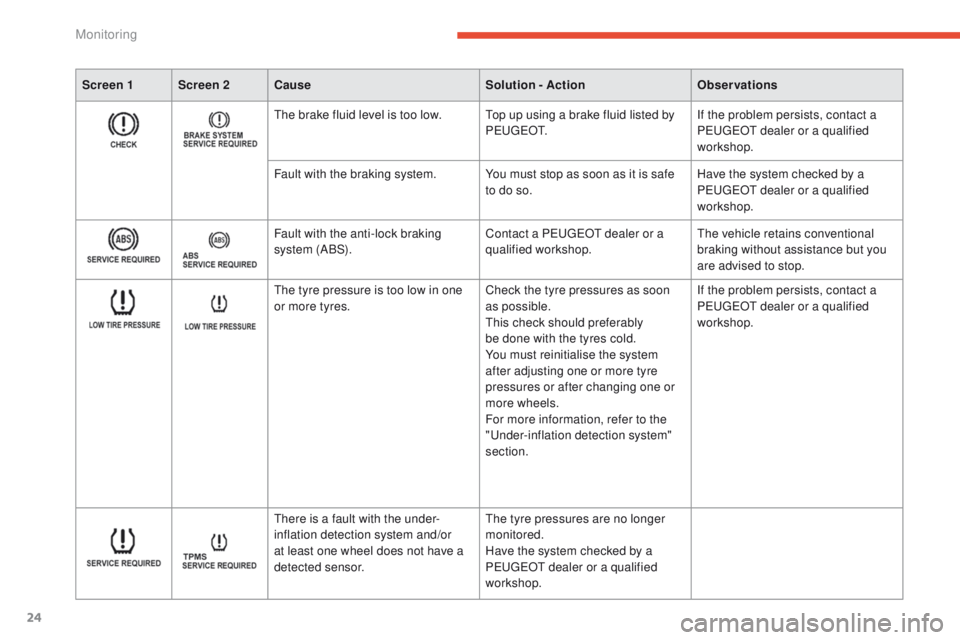
24
the brake fluid level is too low.top up using a brake fluid listed by
Pe u g eOt .If the problem persists, contact a
Pe
ugeOt dealer or a qualified
workshop.
Fault with the braking system. You must stop as soon as it is safe to do so.Have the system checked by a
P
e
uge
Ot
dealer or a qualified
workshop.
Fault with the anti-lock braking
system (ABS). Contact a P
e
uge
Ot
dealer or a
qualified workshop.
th
e vehicle retains conventional
braking without assistance but you
are advised to stop.
th
e tyre pressure is too low in one
or more tyres. Check the tyre pressures as soon
as possible.
th
is check should preferably
be done with the tyres cold.
You must reinitialise the system
after adjusting one or more tyre
pressures or after changing one or
more wheels.
For more information, refer to the
"
un
der-inflation detection system"
section. If the problem persists, contact a
Peuge
O
t dealer or a qualified
workshop.
th
ere is a fault with the under-
inflation detection system and/or
at least one wheel does not have a
detected sensor.
th
e tyre pressures are no longer
monitored.
Have the system checked by a
P
e
uge
Ot
dealer or a qualified
workshop.
Screen 1 Screen 2
Cause Solution - ActionObservations
Monitoring
Page 44 of 389
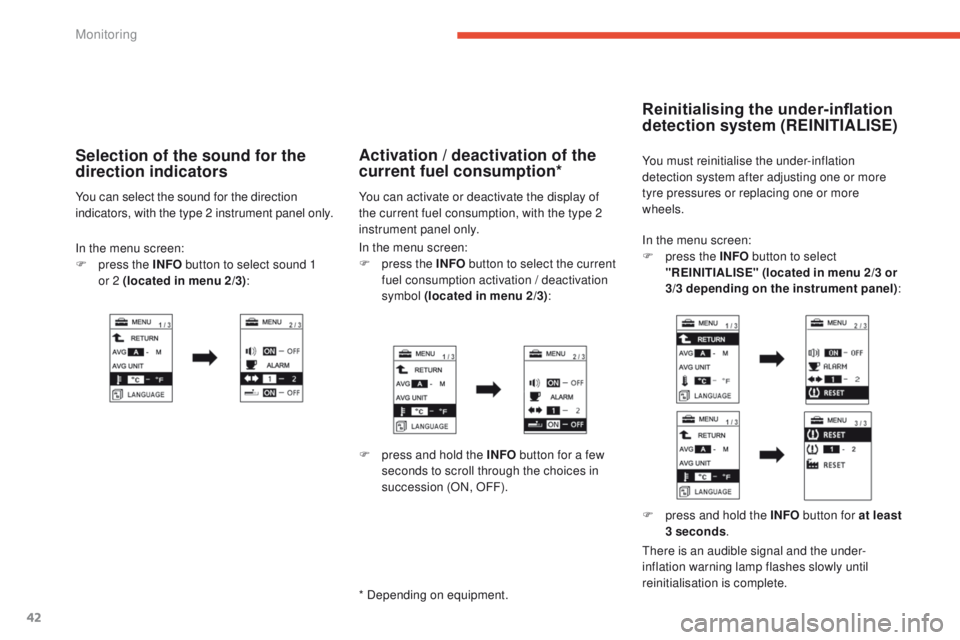
42
In the menu screen:
F p ress the INFO button to select
"REINITIALISE" (located in menu 2/3 or
3/3 depending on the instrument panel) :
Reinitialising the under-inflation
detection system (REINITIALISE)
You must reinitialise the under-inflation
detection system after adjusting one or more
tyre pressures or replacing one or more
wheels.
F
p
ress and hold the INFO button for at least
3 seconds .
ther
e is an audible signal and the under-
inflation warning lamp flashes slowly until
reinitialisation is complete.
In the menu screen:
F
p
ress the INFO button to select the current
fuel consumption activation / deactivation
symbol (located in menu 2/3) :Activation / deactivation of the
current fuel consumption*
You can activate or deactivate the display of
the current fuel consumption, with the type 2
instrument panel only.
F
p
ress and hold the INFO button for a few
seconds to scroll through the choices in
succession (ON, OFF).
* Depending on equipment.
In the menu screen:
F p ress the INFO button to select sound 1
or
2 (located in menu 2/3) :
Selection of the sound for the
direction indicators
You can select the sound for the direction
indicators, with the type 2 instrument panel only.
Monitoring
Page 116 of 389
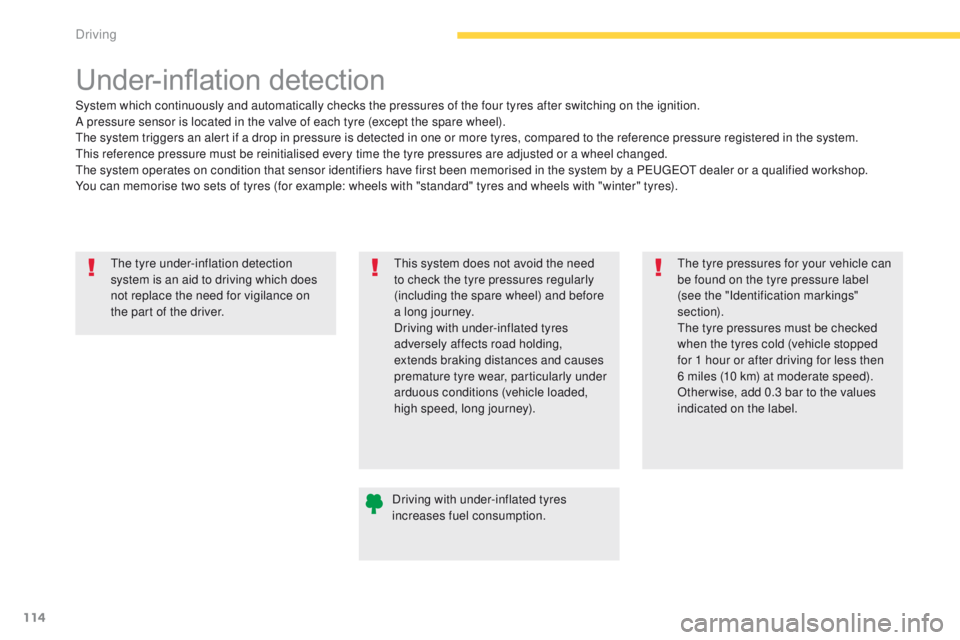
114
the tyre under-inflation detection
system is an aid to driving which does
not replace the need for vigilance on
the part of the driver.
Under-inflation detection
System which continuously and automatically checks the pressures of the four tyres after switching on the ignition.
A pressure sensor is located in the valve of each tyre (except the spare wheel).
th
e system triggers an alert if a drop in pressure is detected in one or more tyres, compared to the reference pressure registered in the system.
th
is reference pressure must be reinitialised every time the tyre pressures are adjusted or a wheel changed.
th
e system operates on condition that sensor identifiers have first been memorised in the system by a P
e
uge
Ot
dealer or a qualified workshop.
You can memorise two sets of tyres (for example: wheels with "standard" tyres and wheels with "winter" tyres).
Driving with under-inflated tyres
increases fuel consumption.
th
is system does not avoid the need
to check the tyre pressures regularly
(including the spare wheel) and before
a long journey.
Driving with under-inflated tyres
adversely affects road holding,
extends braking distances and causes
premature tyre wear, particularly under
arduous conditions (vehicle loaded,
high speed, long journey).
th
e tyre pressures for your vehicle can
be found on the tyre pressure label
(see the "Identification markings"
section).
th
e tyre pressures must be checked
when the tyres cold (vehicle stopped
for 1 hour or after driving for less then
6 miles (10 km) at moderate speed).
Other wise, add 0.3 bar to the values
indicated on the label.
Driving
Page 117 of 389
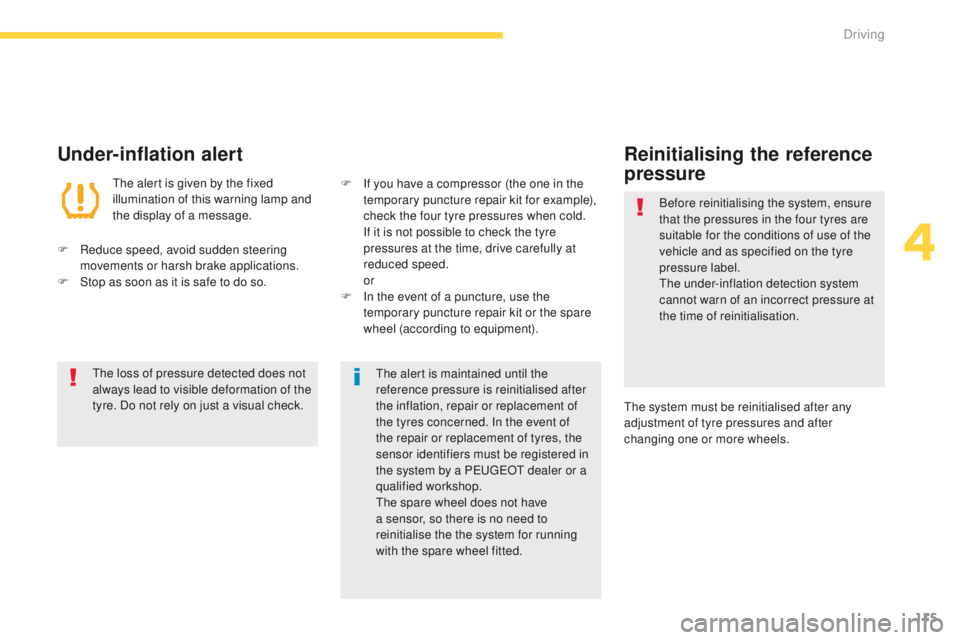
115
Under-inflation alert
the alert is given by the fixed
illumination of this warning lamp and
the display of a message.
F
R
educe speed, avoid sudden steering
movements or harsh brake applications.
F
S
top as soon as it is safe to do so.
th
e loss of pressure detected does not
always lead to visible deformation of the
tyre. Do not rely on just a visual check.
th
e alert is maintained until the
reference pressure is reinitialised after
the inflation, repair or replacement of
the tyres concerned. In the event of
the repair or replacement of tyres, the
sensor identifiers must be registered in
the system by a P
e
uge
Ot
dealer or a
qualified workshop.
th
e spare wheel does not have
a sensor, so there is no need to
reinitialise the the system for running
with the spare wheel fitted.
F
I f you have a compressor (the one in the
temporary puncture repair kit for example),
check the four tyre pressures when cold.
I
f it is not possible to check the tyre
pressures at the time, drive carefully at
reduced speed.
or
F
I
n the event of a puncture, use the
temporary puncture repair kit or the spare
wheel (according to equipment).
Reinitialising the reference
pressure
Before reinitialising the system, ensure
that the pressures in the four tyres are
suitable for the conditions of use of the
vehicle and as specified on the tyre
pressure label.
th
e under-inflation detection system
cannot warn of an incorrect pressure at
the time of reinitialisation.
th
e system must be reinitialised after any
adjustment of tyre pressures and after
changing one or more wheels.
4
Driving
Page 118 of 389
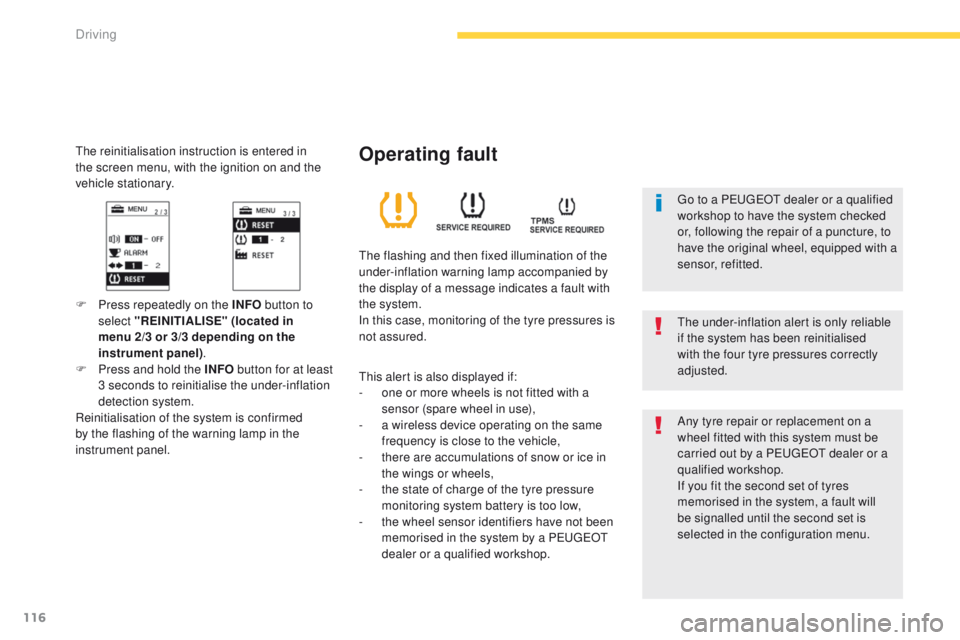
116
the reinitialisation instruction is entered in
the screen menu, with the ignition on and the
vehicle stationary.
F Press repeatedly on the INFO button to
select "REINITIALISE" (located in
menu 2/3 or 3/3 depending on the
instrument panel) .
F
P
ress and hold the INFO button for at least
3 seconds to reinitialise the under-inflation
detection system.
Reinitialisation of the system is confirmed
by the flashing of the warning lamp in the
instrument panel.
th
e under-inflation alert is only reliable
if the system has been reinitialised
with the four tyre pressures correctly
adjusted.
Operating fault
the flashing and then fixed illumination of the
under-inflation warning lamp accompanied by
the display of a message indicates a fault with
the system.
In this case, monitoring of the tyre pressures is
not assured.
th
is alert is also displayed if:
-
o
ne or more wheels is not fitted with a
sensor (spare wheel in use),
-
a w
ireless device operating on the same
frequency is close to the vehicle,
-
t
here are accumulations of snow or ice in
the wings or wheels,
-
t
he state of charge of the tyre pressure
monitoring system battery is too low,
-
t
he wheel sensor identifiers have not been
memorised in the system by a P
e
uge
Ot
dealer or a qualified workshop. Any tyre repair or replacement on a
wheel fitted with this system must be
carried out by a P
e
uge
Ot
dealer or a
qualified workshop.
If you fit the second set of tyres
memorised in the system, a fault will
be signalled until the second set is
selected in the configuration menu.
go t
o a P
e
uge
Ot
dealer or a qualified
workshop to have the system checked
or, following the repair of a puncture, to
have the original wheel, equipped with a
sensor, refitted.
Driving
Page 119 of 389
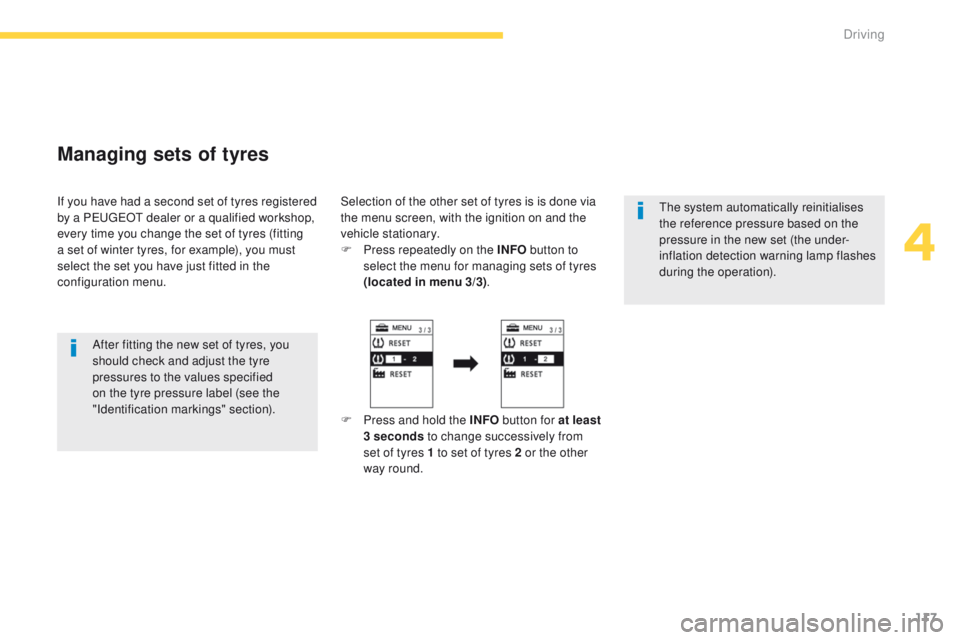
117
Managing sets of tyres
If you have had a second set of tyres registered
by a PeugeOt dealer or a qualified workshop,
every time you change the set of tyres (fitting
a set of winter tyres, for example), you must
select the set you have just fitted in the
configuration menu.
After fitting the new set of tyres, you
should check and adjust the tyre
pressures to the values specified
on the tyre pressure label (see the
"Identification markings" section). Selection of the other set of tyres is is done via
the menu screen, with the ignition on and the
vehicle stationary.
F
P
ress repeatedly on the INFO button to
select the menu for managing sets of tyres
(located in menu 3/3) .
F Press and hold the INFO button for at least
3 seconds to change successively from
set of tyres 1 to set of tyres 2 or the other
way round.
the
system automatically reinitialises
the reference pressure based on the
pressure in the new set (the under-
inflation detection warning lamp flashes
during the operation).
4
Driving
Page 176 of 389
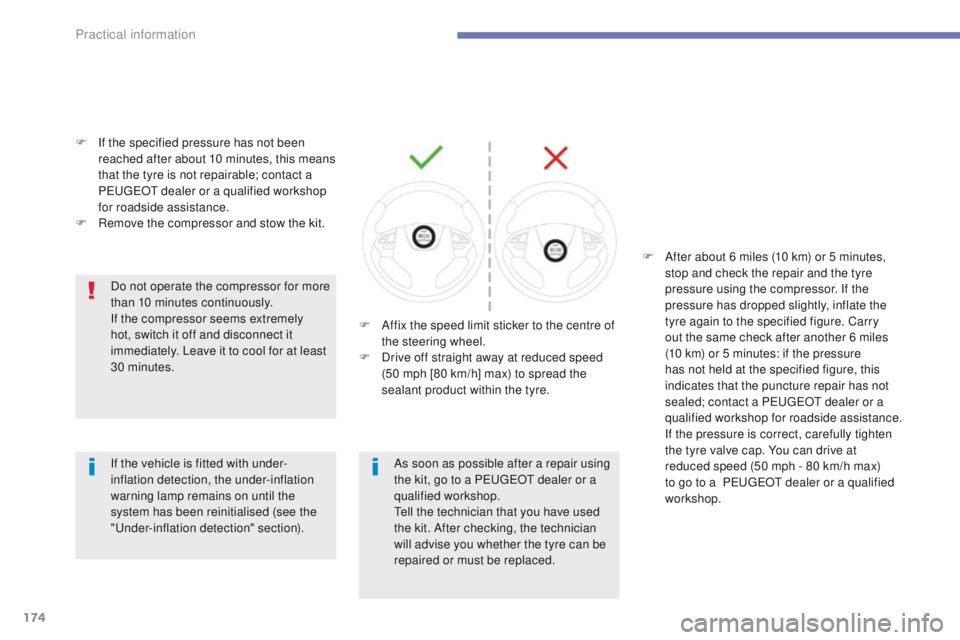
174
F If the specified pressure has not been reached after about 10 minutes, this means
that the tyre is not repairable; contact a
P
e
uge
Ot
dealer or a qualified workshop
for roadside assistance.
F
R
emove the compressor and stow the kit.Do not operate the compressor for more
than 10 minutes continuously.
If the compressor seems extremely
hot, switch it off and disconnect it
immediately. Leave it to cool for at least
30 minutes.
As soon as possible after a repair using
the kit, go to a P
e
uge
Ot
dealer or a
qualified workshop.
te
ll the technician that you have used
the kit. After checking, the technician
will advise you whether the tyre can be
repaired or must be replaced.
If the vehicle is fitted with under-
inflation detection, the under-inflation
warning lamp remains on until the
system has been reinitialised (see the
"
un
der-inflation detection" section). F
A
ffix the speed limit sticker to the centre of
the steering wheel.
F
D
rive off straight away at reduced speed
(50 mph [80 km/h] max) to spread the
sealant product within the tyre. F
A
fter about 6 miles (10 km) or 5 minutes,
stop and check the repair and the tyre
pressure using the compressor. If the
pressure has dropped slightly, inflate the
tyre again to the specified figure. Carry
out the same check after another 6 miles
(10 km) or 5 minutes: if the pressure
has not held at the specified figure, this
indicates that the puncture repair has not
sealed; contact a P
e
uge
Ot
dealer or a
qualified workshop for roadside assistance.
I
f the pressure is correct, carefully tighten
the tyre valve cap. You can drive at
reduced speed (50 mph - 80 km/h max)
to go to a
P
e
uge
Ot
dealer or a qualified
workshop.
Practical information
Page 340 of 389
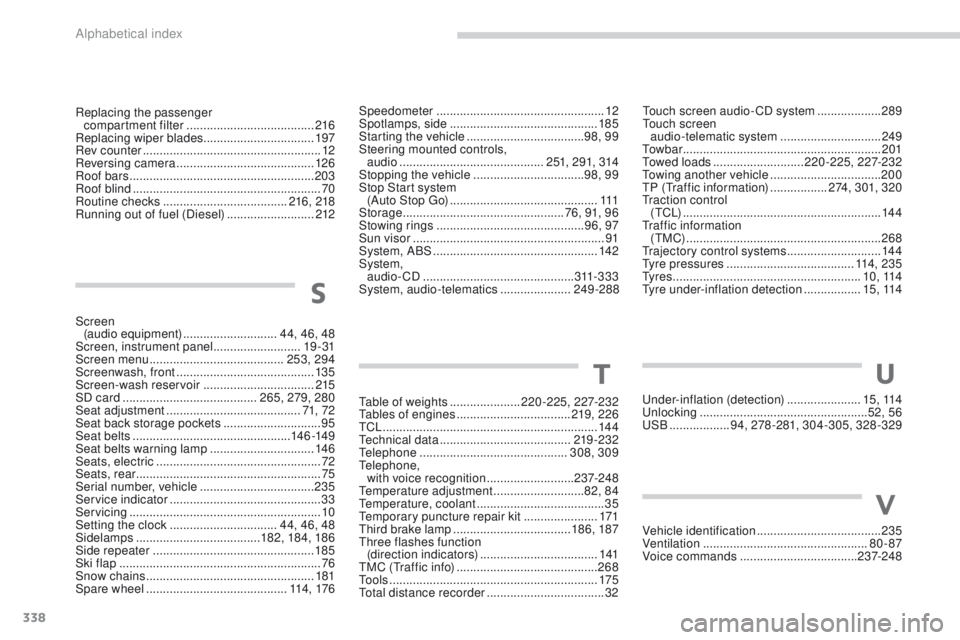
338
Speedometer .................................................. 12
Spotlamps, side ............................................ 185
Starting the vehicle
................................... 98, 99
Steering mounted controls, audio
........................................... 251, 291, 314
Stopping the vehicle
.................................98, 99
Stop Start system (Auto Stop
g
o
)
............................................ 111
St
orage
................................................ 76, 91, 96
Stowing rings
............................................ 96, 97
Sun visor
......................................................... 91
System, ABS
................................................. 142
System, audio-CD
..............................
...............311-333
System, audio-telematics
..................... 24
9 -288to uch screen audio- CD system ...................
289to
uch screen
audio-telematic system
.............................. 24
9
to
w b a r
...........................................................201
to
wed loads
...........................220-225, 227-232
to
wing another vehicle
.................................20
0
tP
(
tr
affic information)
.................2
74, 301, 320
tra
ction control
(
tC
L)
...........................................................14 4
tr
affic information
(
tM
C)
...............................
...........................268
tr
ajectory control systems ............................14 4
ty
re pressures
......................................114 , 2 3 5
ty
r e s
........................................................1 0 , 114
ty
re under-inflation detection
.................15 , 114
un
der-inflation (detection)
......................1
5 , 114
unl
ocking
..............................
....................52, 56
u
SB
..................94, 278 -281, 304-305, 328 -329
Vehicle identification
.....................................235
Ventilation
..............................
...................80 - 87
Voice commands
...................................2 37-24 8
U
V
T
table of weights .....................2 20-225, 227-232tab
les of engines .................................. 219, 226
t
CL
................................................................ 14 4
te
chnical data
....................................... 219 -232
te
lephone
............................................ 308, 309
te
lephone,
with voice recognition
..........................2 37-24 8
te
mperature adjustment
........................... 8
2, 84
te
mperature, coolant
...................................... 35
te
mporary puncture repair kit
......................171
th
ird brake lamp
................................... 18 6, 187
thr
ee flashes function
(direction indicators)
...................................141
tM
C (
tr
affic info)
.......................................... 26
8
to
o l s
.............................................................. 175
to
tal distance recorder
...................................32
Screen
(audio equipment)
............................
44, 46, 48
Screen, instrument panel
..........................
19 - 31
Screen menu
........................................
253, 294
Screenwash, front
.........................................
13 5
Screen-wash reservoir
.................................
215
SD card
........................................
265, 279, 280
Seat adjustment ...............................
......... 71, 72
Seat back storage pockets
............................. 95
Se
at belts
............................................... 14
6 -149
Seat belts warning lamp
............................... 14
6
Seats, electric
................................................. 72
Seats, rear
....................................................... 75
Serial number, vehicle
.................................. 23
5
Service indicator
............................................. 33
Servicing
...............................
.......................... 10
Setting the clock
................................ 44, 46, 48
Sidelamps
..................................... 182, 18 4, 18 6
Side repeater
..............................
.................. 185
Ski flap
..............................
.............................. 76
Snow chains
.................................................. 18
1
Spare wheel
...............................
........... 114 , 17 6
S
Replacing the passenger
compartment filter ...................................... 216
Replacing wiper blades .................................197
Rev counter
..................................................... 12
Reversing camera
......................................... 126
Roof bars
....................................................... 20
3
Roof blind
........................................................ 70
Routine checks
..................................... 216, 218
Running out of fuel (Diesel)
..........................2
12
Alphabetical index